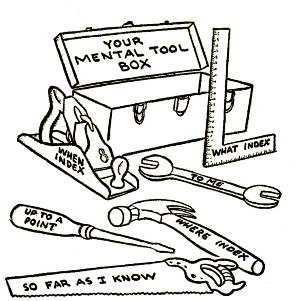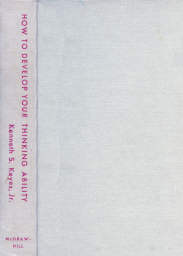How would you like to:
1. Get along better with other people
2. Build a happier marriage.
3. Be successful in business.
4. Find causes for things that worry you.
5. Do your part to build a world free from war and want.
Does this sound like something written for survival in the 21st Century? If so, it's because these five universal wants are still as important today as they were when Keyes wrote this book over fifty years ago. And the answers he gives on how to accomplish these things are based on writings that go back to 80 years ago when a then obscure Polish count by the name of Alfred O. Korzybski first began to write down his ideas in "Time Binding", "Manhood of Humanity", and "Science and Sanity". In his Acknowledgments, Keyes lists Korzybki first and farther down includes Wendell Johnson. Johnson I had encountered back in 1964 through his book, "People on Quandries", whose subtitle, "The Semantics of Personal Adjustments," must have caught my eye as I searched the New Orleans Public Library shelves looking for answers to my quandries and personal adjustments. If I had but read the Introduction of Johnson's book back then in my callow youth, I would have discovered Korzybski much earlier. Instead I found Johnson, an original student of Korzybski, and read his work with interest. In Keyes, whom I discovered fifteen or so years later, I found another student of Korzybski, one who made the understanding of General Semantics much clearer to me than any other writer, including Korzybski and Johnson, on a par with another superb writer and student of Korzybi's, Samuel Bois, who wrote "Art of Awareness."
When I was asked to take over a course in Effective Communication at a nuclear power
station in the early 1980s, I pulled out this book because of its common sense tools for thinking and
Ted Key's marvelous cartoons(1) which illustrated those tools simply and clearly. I had read Johnson and
Bois back in the 1960s, but because I had not yet read Adler's book, "How To Read A Book", I had
not yet read a Preface, Foreword, or Introduction and had not yet discovered the progenitor of their
ideas, Alfred O. Korzybski. But, unbeknownst to me at the time, I had a direct encounter with a key
idea of Korzybski back in 1975 when I was having a discussion with my manager in the Software
Research Department of the Foxboro Company, Per Holst. He told me about a section in the
Norwegian Boy Scout Handbook on Map Reading that he had memorize when he was a youth. It
said, "When the terrain differs from the map, believe the terrain." I smiled and quickly committed
that quotation to memory. It certainly makes imminently good sense in Norway, when a single step
in the wrong direction might cause a precipitous plunge 3,000 feet into an icy fiord. What I had
learned was a variation on the phrase that was to learn, several years later, that was attributed to
Korzybski, "The map is not the territory." I was a Senior Software Researcher and I suppose Per was
telling me that in research one needs to build valid maps of unexplored terrain and one should be
careful to beware of secondhand maps that could lead me into trouble, that a map is not a substitute
for using my own eyes. I was looking into a crystal ball at the future of software development and if I
had read this book, I would have had six marvelous tools to assist me right away. To understand the
value of these six tools, one needs to comprehend six basic obstacles to the truth, whether the truth
exists in doing detective work on a past event or projective work on future events (as I was as a
software researcher). The cartoon on page 145 illustrates them and lists them for us.
In the Tool Box at right, you will find
the Six Tools for Thinking that can help you to make adequate maps in the face of
each of the six obstacles to truth [Tool in Brackets]:
1. You can never know all about anything. [So far as I know.]
2. No two things are identical. [The What Index]
3. Things may act differently in new places. [The Where Index]
4. Thing exist in varying degrees. [Up to a Point]
5. Things appear differently to different people. [To Me]
6. Everything changes. [The When Index]
1. When I was working in software research and development, if I had a question about how a piece of computer hardware or software worked, I could usually find the expert in that area and ask my question. I was amazed bt the number of times that even the most knowledgeable expert was unable to answer my question. When they were faced with my question, they would usually give me their best answer followed by a qualification along the lines of "so far as I know." See cartoon and apply this tool: "Nonsense! There couldn't be any whales in this bay, so far as I know."




